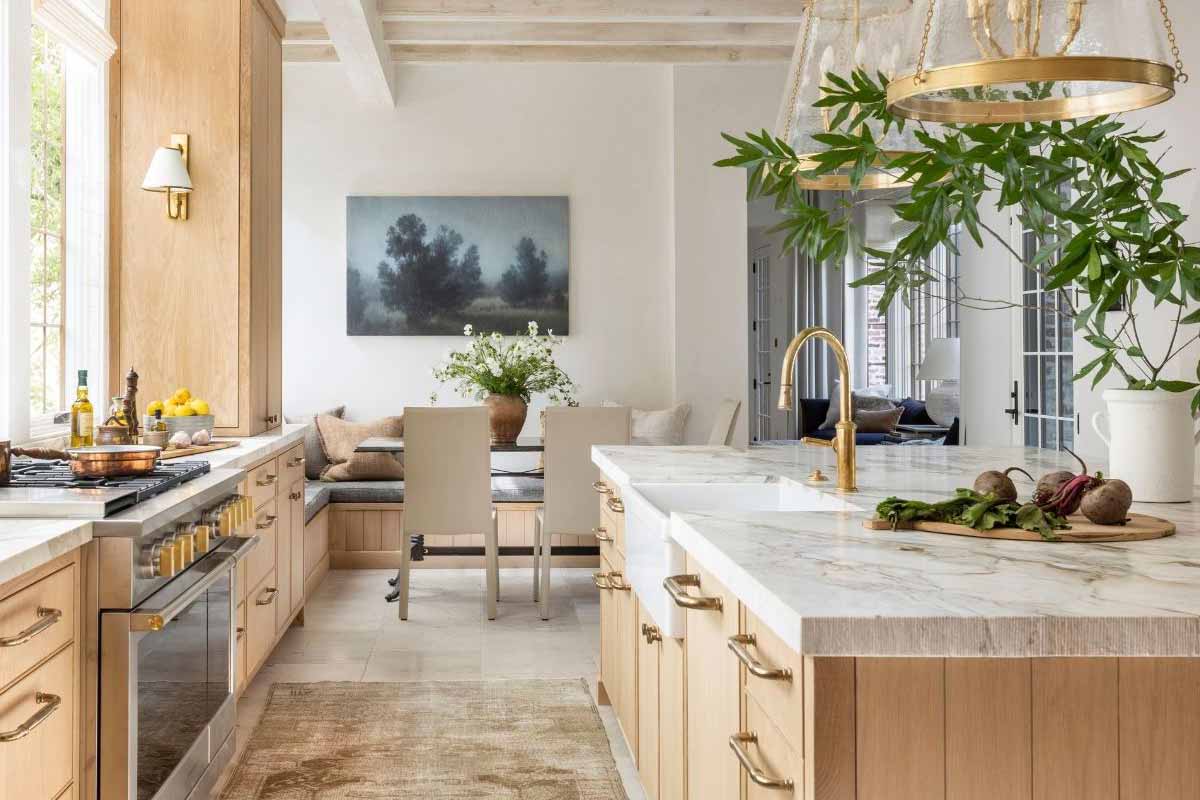Pick the right countertop material, and a kitchen suddenly feels like a living room for cooks. We gather there, plan, snack, talk, and occasionally dance with a spoon in hand. Design pros feel that shift too, and the new NKBA report backs it up. Kitchens are growing, doing more, and shaping the rest of the home. Let’s cut through the noise and look at what’s actually landing in real projects.
Where style is heading
Designers still lean on transitional style because it plays nice with daily life. Clean lines meet warm details. Think flat-front doors next to a classic range, or a tailored island paired with cozy stools. That blend wins votes across the industry, outpacing strict minimalism. Farmhouse, cottage, and themed looks fade as homeowners seek spaces that age gracefully. Cabinet doors slim down, hardware gets quieter, and appliances hide behind matched panels.
Floor-to-ceiling storage pulls everything into a tidy envelope. Even the island gets sleeker, with slender legs or a simple monolith form. The point isn’t to impress a showroom. It’s to live better, with choices that still feel good five years from now. Your countertop material sits in the middle of that conversation, bridging modern edges and familiar warmth.
Color, Calm With a Twist
Despite splashy headlines about bold palettes, real kitchens still favor calm neutrals. Warm whites, soft taupes, pale greige, smoked gray, even inky black when a room gets sun. Then comes the twist: green and blue keep gaining. Not neon, think eucalyptus, olive, stormy teal, sea glass. They arrive in measured ways: a painted island, a tiled nook, a patterned runner. Backsplashes become the stage for expression, sometimes with quiet veining that reads like art.
Wallpaper sneaks into butler’s pantries and beverage corners where mess is light. Metal finishes mellow out, moving to brushed brass, gunmetal, or soft nickel. Lighting joins the mood with sculptural pendants and thin-profile under-cabinet strips. Color still listens to the room’s bones light, ceiling height, floors then builds from there. When the palette hums, your countertop material becomes the anchor that steadies the whole story.
countertop material
Quartz rules home kitchens for simple reasons: reliable look, no fussy sealing, strong day-to-day durability. Quartzite attracts purists who want true stone with character and a tougher feel than marble. Granite’s once-automatic status has cooled; the patterning can boss a room around. Marble remains dreamy, but folks pick it with eyes open, etches, patina, and all the romance. Designers keep steering clients to lighter surfaces against deeper cabinets, which flips the usual weight. Matte and honed finishes take glare down and photograph beautifully. Edges shift too. You’ll see square eased profiles, classic bullnose, and waterfall ends where the slab drapes to the floor. Some kitchens split personalities: one tone on the perimeter, another on the island. Others keep a single surface for calm continuity. There isn’t a right answer, only the life you lead.
Bake every weekend? Choose a countertop material that shrugs off heat and stains. Host cocktail nights? You’ll want a finish that forgives a lime wedge and a splash of red wine. If you love the look of marble but not the upkeep, quartz with feathery veining scratches that itch. If you crave stone that feels born, not built, quartzite delivers with grit and grace. Either way, your countertop material sets the tone before a cabinet door even swings.
Backsplashes That Work Hard
Tile still covers most kitchen walls because it’s tough, cleanable, and endlessly flexible. Ceramic and porcelain lead the pack with styles from handmade to razor-precise rectified edges. Large formats cut grout lines to a minimum, which makes cleanup feel less like a chore. Then there’s the rising move to slab backsplashes. Carry your countertop material right up the wall and the room calms instantly. Fewer seams, fewer visual breaks, more of that serene, continuous vibe. Veins can bookmatch behind the range like a quiet mural.
Accessories keep the look alive: slim shelves in matching stone, a ledge for oil and salt, magnetic strips hidden under the slab. Matte metals echo the softness of honed surfaces. Sinks follow suit in stone composites or finishes that don’t scream for attention. Shiny everything had a moment; now the glow is subtler. It feels restful, even when dinner hits the full-stove, three-pan sprint.
Floors, Zones, and Little Luxuries
Underfoot, wide planks rule. Engineered wood wins for stability and friendly care, especially in busy homes. Tones stay light and warm, keeping kitchens open and airy. Some swap in resilient options that mimic oak so well you need to touch them. The goal is simple: fewer seams, less fuss, a floor that carries the eye across the room. Beyond surfaces, kitchens grow new wings. Beverage stations show up with built-in espresso dreams and undercounter fridges. Pet feeding zones finally get a proper place, away from chair legs and traffic jams. Mudrooms link to the kitchen for bags, boots, and the daily unload. Eat-in corners turn mornings into small rituals.
A desk nook holds schedules, chargers, and the never-ending mail. All these micro-zones keep traffic sane and habits easy. They also guide materials, lighting, and storage decisions with real life in mind. When you map the space around how you live, the rest clicks into place. Pick a countertop material that matches those rhythms, and the room feels like it’s on your side. It’s not just style, it’s support. Make friends with the choices that meet you where you are. That’s the difference between a pretty kitchen and a keeper.
